Stories and photos by Shabna Ullah
Residents of Sandvoort, an agricultural village in West Canje, Berbice whose residents are close-knit, have been involved in self-help activities from the inception. Reliving a part of the history, Thourald Sinclair, acting chairman of Sandvoort Village Co-op Society told the Sunday Stabroek that “when the village was bought, residents worked together to build it.”
Recently, residents did the same to establish a library that was badly needed in the community, thanks to the help of Peace Corps volunteer, Matthew Cusimano.
Tucked away on the outskirts of New Amsterdam, Sandvoort is located after the village of Lochaber. It is also bordered by Rising Sun and three other small villages that have all been abandoned owing to a sea-defence breach. The privately-owned land is being rented out for agricultural purposes.
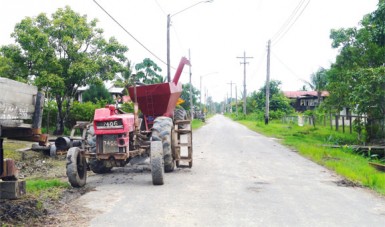
Sinclair said the roads are “becoming navigable and I’m seeing signs that it would be developed again as a residential area.” The roads, he said have been fixed for easy access for farmers.
With a population of over 200, the village has a health centre, Adventist church, shops and a primary school to which the community library has been added.
Like other residents, Sinclair said the village has always been peaceful and looking back at when “I was a little boy to now, much wasn’t changed in that regard.” According to him, “The peace may be disrupted in the homes at times but that doesn’t affect the community relationship,” going on to remark that “teeth and tongue must bite.”
He told this newspaper too that residents look out for each other, and that when he prays for the safety of his grandchildren who travel out of the community for school, he prays for the other children as well.
He said the lack of job opportunities has forced many persons to migrate from the area while others are “trying to create jobs for themselves.”
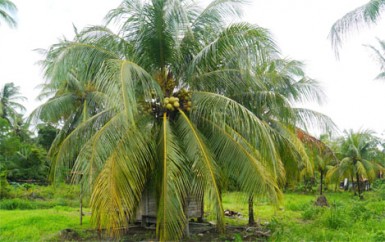
Residents are involved in the grocery business, rice and cash crop farming and vending their produce on weekends. “Instead of going to New Amsterdam to shop, the money can circulate in the community,” Sinclair said. The village has teachers, including one of Sinclair’s daughters, police officers, nurses and trainee nurses. One of his sisters is a retired nurse.
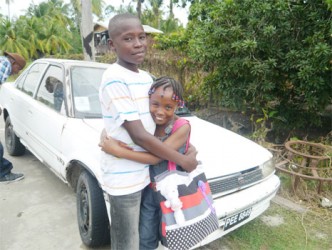
The eldest of 10 siblings, his father worked at the Lochaber sugar estate and “travelled a lot; most of his work took place in different parts of the Caribbean and in Africa.” He went on to relate that, “Because my father was always away, I grew up with many fathers,” a reference to the older men in the community who took care of him.
He recalled that at age 13 he did not know how to ride a bicycle, and a resident ensured that he learnt within a day. The man asked him to run an errand to the shop and lent him a bicycle but he walked instead. When he returned the man taught him to ride.
Residents were bemused that “from a few uneducated slaves,” Sandvoort has produced teachers, lawyers, doctors, nurses, tradesmen of all sorts, civil servants and sea captains.
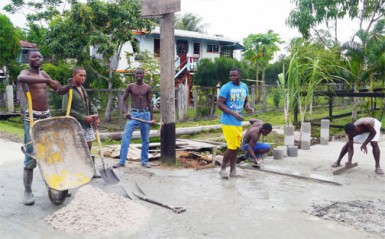
When the area benefited from electricity for the first time on December 31, 2002 residents were elated. They saw it as a big gift to the community as they no longer had to depend on lamps. Soon after, they also enjoyed the luxury of having refrigerators, televisions and other electrical appliances in their homes.
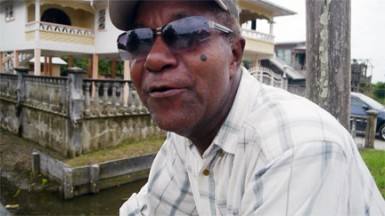
Lewis Hope, a pensioner was happy that the community also has water and telephone services. He said that “we got everything now.”
According to him, “I born and grow up on the Corentyne and I have been living here for the past 56 years when I got married.” He worked for a number of years at the Guyana Water Authority and at McKenzie as a supervisor.
He found the residents to be “nice and friendly; everyone live in unity. The community is safe. We don’t have thieving and so happening here…” He said too, “You could leave your clothing, footwear or even your vehicles outside and you wake up and meet it.”
Hope observed while the village has gone a far way in terms of development, it needs a sports ground for the youths and that a plot of land had already been earmarked.
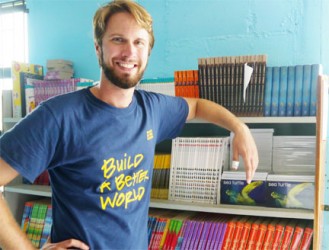
The children were home on holiday when this newspaper visited and were having a lot of fun fishing, riding bicycles, bouncing a basketball along the road and the best part, swimming in the trench. Nine-year-old Kayla and her brother, Wayne, were playing in their yard as this reporter spoke to residents in front of their home. Shortly after they came back with fishing rods and placed them in the trench, waiting patiently for the fish to bite. Before long, Kayla became very excited when she caught a fish and proudly displayed her catch to this newspaper.
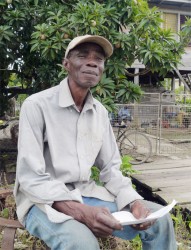
They were planning to put the fish “in the aquarium.” Sinclair said the older children would “clean the fish and cook them” though.
Michael April, 17, a boxer came bouncing a basketball down the road. He had represented Guyana in boxing competitions in Peru where he won one match and lost the other. Being pleased with his overall performance, Michael, who trains at Roberts Champion Boxing Gym in New Amsterdam is “looking forward to doing it again.” He joined the gym over four years ago and plans to take his career to a “higher level and be somebody that I’m supposed to be.” He attends Tutorial High and is preparing for the CSEC exams this year.
He too said that “the village should have a playfield and said the “youth should come together and do a sport that they all like.”
“If we have a basketball court and a football field,” he continued, “we would do well in here. We just need a little support.” The youths would “come out and play… we have the skills and the willpower to excel if given the support.”
The teen said too that “Guyanese have a lot of talents” and that the lack of opportunities in the community “is leading to the downfall of the youth. It is leading them to go and smoke and consume alcohol, which they’re not supposed to be involved in.”
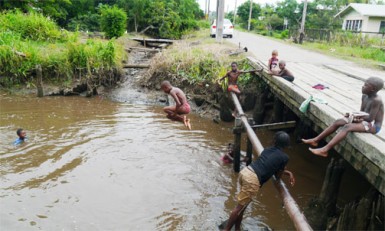
Cusimano agrees that the village is peaceful and said, “Sometimes the quietness reminds me of the interior.” He has been in Guyana for the past two years and in the village since March 2012.
Sandvoort, he said, is “not so far away from Georgetown and is accessible to New Amsterdam pretty easily. So it is like the best of both worlds.” To him, “the children are fantastic.”
He agrees that the village lacked activities and said the nearest playfield is at Lochaber. Developing a playfield, which a resident had started a while ago, is another project the village is looking into.
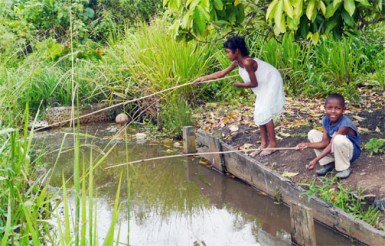
Cusimano, a teacher at Sandvoort Primary, was pleased to be involved in setting up the library and getting the residents to be engaged in self-help work. He had done the “grant writing” for the project which was approved by the Better World Books foundation that provided US$2,800 in books and shipping costs. He was happy that out of 100 applications around the world looking for funding for library projects, Sandvoort was among the three that were chosen.
Funding also came from private donors in the USA and Canada.
REDbandaid Foundation as well as other donors in Georgetown helped with US$750 worth of materials while other local persons also pitched in.
Keron Haywood, 13, a student of Canje Secondary was enjoying his holiday. When this newspaper caught up with him he was dressed and waiting to go out. He was soon joined by his younger sister, Rodessa, who attends the Lochaber Primary, and then his parents. They left in their car which was parked by the roadside to visit relatives. Keron said he loves music and had been given a guitar for Christmas.
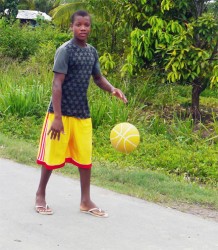
His grandmother, Mavis Sinclair, 72, is one of the hard-working women in the village. She did almost everything to survive, including sewing, baking, icing cakes, catering, rearing poultry and fishing with a castnet. She still loves to bake and would set aside Fridays for baking bread for the family. They enjoy the homemade bread but she would still purchase from the shops on days when the bread would “run out.”
One of her daughters has learnt the art of icing cakes from her and has even upgraded her skills while another is an excellent cook and can handle large amounts at one time. She reminisced that her mother, Mother Dorothy Edwards who died at age 92, was an “all-rounder and the beauty is that she taught me to do every little thing… I got my skills from her,” she laughed.
Her mother also wanted her to learn to play the piano and she was taught by her cousin, Moses Telford, who now resides in the states. She played the piano for her church choir. Although she still has her talent she does not play much now “because I don’t see that well.” She had taught her eldest son to play as well.
History
Thourald Sinclair said that history of the village goes right back to 1777 when the plantation was owned by the Berbice Society (Company) and grew cotton, coffee and cacao. It was also to a lesser extent, a sugar estate.
Reading from a docu-ment, he said Sandvoort was established soon after the abolition of slavery as a self-governing village. The entire area was owned by Edward John London.
The first community was located two miles up the west bank of the Canje River and was occupied by three dominant tribes of African descent: Oku, Quashy and Congo.
At that location, the village was divided into two sections after the Dutch and the English and was thus called Dutch Quarter and English Quarter. But the people lived and worked together.
Upon establishing the village, resi-dents continued with agriculture and “soon expanded to other skills because of the economic need for survival.” Balata bleeding was also a main means of livelihood for many.
A school was also established through initial help from the Mission Chapel Church and in a very short time teachers came out from among the residents.
At the time, “Residents were facing difficulties with drainage and irrigation but they fixed those problems through self-help with their hands.”
The area held a yearly thanksgiving which bonded the residents. It consisted of music, drama and storytelling along with prayers.





